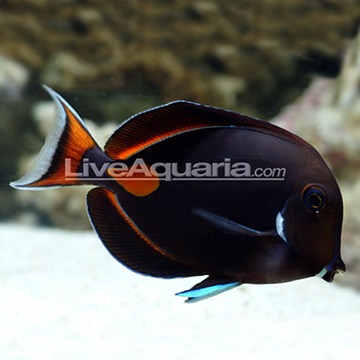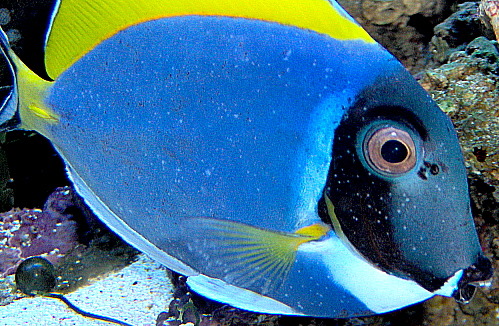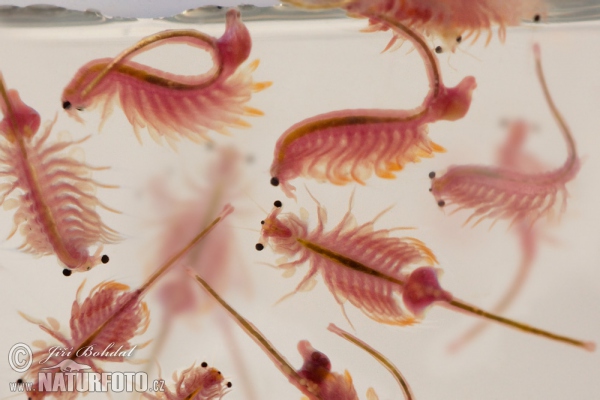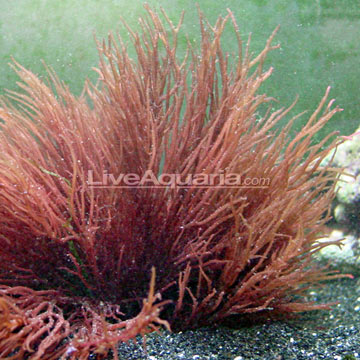I know what you're thinking, "Thank God!". And yea, I'm just as excited as you are
(that's a lot of excitement)! For those of you that don't know, and that's probably most of you, Coralline is my Achilles Tang. As a majority of you do know (sarcasm was on sale today), Achilles Tangs are some of the most difficult fish to keep in home aquariums, so I'm pretty thrilled mine has adjusted so well.
 |
| Achilles Tang looking all sexy like (the watermark is a lot harder to see in person). |
But that still doesn't answer the question of what "Coralline is eating pellets!" actually means. So today, I'm going to talk about what makes a fish an aquarium fish and why we can't all have killer whales in our pools.
But I want THAT one!
Aquarium life isn't for everyone. It's also not for every fish. The saltwater aquarium hobby has come a long way since undergravel filters and daily water changes, but unfortunately we're still unable to emulate the exact same conditions found out in the oceans.
 |
| My next aquarium I'm working on, eta unavailable. (ocean.goodplanet.org) |
There are too many variables for us to try and balance simultaneously. There's not just the salinity (the specific concentrations of chemical compounds), but there's also the lighting, diet, water movement, nutrient levels, having HBO so they don't miss out on Game of Thrones, and so on.
 |
| Is this weird? This is weird isn't it. |
And some fish just don't make the transition well into the home aquarium. A majority of these fish either refuse to eat (and this can be for a number of reasons) or catch ich. Ich is a common aquarium parasite that really tests a fish's hardiness. It's about as common as a cold. It usually isn't a question of whether your fish is going to get ich, but more so whether or not they'll survive it.
 |
| Those white spots are not beauty marks. (ichthyologist.tumblr.com) |
The key to beating ich is to keep the fish's water in ideal conditions, and more importantly to make sure that the fish continues to eat. Remember how I said fish that don't make it usually aren't eating? Well, that's another thing you have to cater to.
Who doesn't love pellets?!
One of the toughest things to do, and absolutely the most important, is getting a new fish to eat aquarium food. A lot of fish in the aquarium trade are caught in the ocean. They've never seen what flake food or pellet food looks like, nor are they that interested in trying it out.
 |
| Even when it's endorsed by celebrity fish. (liveaquaria.com) |
High quality aquarium food is enriched with essential vitamins and minerals, ensuring that fish will stay in optimum health so long as they eat. But again, how do you get a fish that's used to fresh, live food to want to eat slow-sinking brown chunks?
 |
| "I'm still not eating that." |
There are a few ways. The method I prefer is feeding my new fishy friend a live or frozen diet of whatever they're used to. Generally this includes either mysis shrimp or brine shrimp for carnivores and some type of seaweed for herbivores.
 |
| Brine shrimp, also referred to as "sea monkeys" (just add water!). (naturephoto-cz.com) |
 |
| Red gracilaria, a favorite seaweed of tangs and other herbivores. |
Normally I'll feed them only their natural food at first, then slowly I'll start tossing in a few pellets of food with their meal. It also helps if you have some fish that are already eating pellets. That way the new non-pellet-eating fish will take the hint when they see the other fish eating. Even so, it took almost 3 months for Coralline to start eating pellets.
 |
| "Pellets are so mainstream." (spreadshirt.com) |
But not all fish make this transition. Some refuse to ever eat pellets or any type of flake food. Some won't get all the nutrition they require solely from pellet food, so you'll be feeding them a special diet forever. Pellets represent the epitome of aquarium acclimation. A fish that's eating pellets is a fish that has embraced aquarium life. A fish that is eating vitamin enriched food is a happy, healthy fish.
 |
| "We love pellets!" |
That's a picture I took last week. From left to right: Yellow Tang, Powder Blue Tang, Tomato Clown, Achilles Tang, and Royal Gramma.
 |
| Here's a better picture of Coralline. |
And that's why I'm so happy that Coralline is eating pellets. As long as she continues to keep a strong appetite and eats vitamin enriched food, her future as a happy, healthy fish is almost guaranteed. Additionally, Achilles Tangs are notorious for catching ich and not eating in home aquariums. So much so that
LiveAquaria even lists them as "Expert Only: ... best kept by the most advanced hobbyists and research institutions." Things could change, and one day she may decide she hates her glass home, but for now she's a beautiful rare fish friend of mine, and I couldn't be happier.
.jpg) |
| Newest shot that I have of the happy tank. |
Thanks for stopping by! As always, if you have any questions, please don't hesitate to ask.











.jpg)
i'm extremely happy to hear that he's doing great and this has been so far my favorite read. No offense to nemo and company but this is really useful information. thanks for sharing and you've bolstered what i already knew, that when i set up my fish tank i need to hire you lol.
ReplyDelete